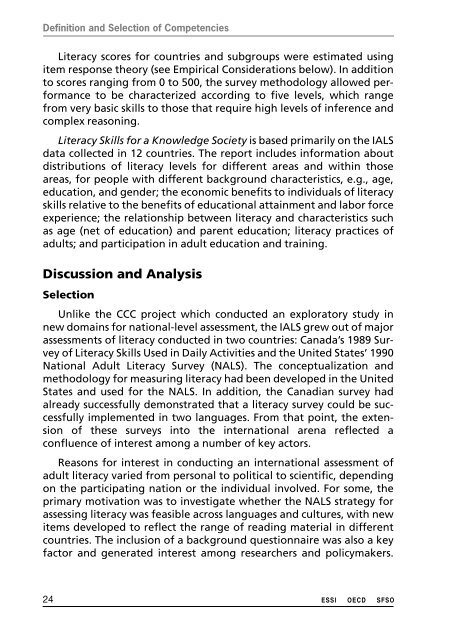Projects on Competencies in the OECD Context - Analysis - DeSeCo
Projects on Competencies in the OECD Context - Analysis - DeSeCo
Projects on Competencies in the OECD Context - Analysis - DeSeCo
You also want an ePaper? Increase the reach of your titles
YUMPU automatically turns print PDFs into web optimized ePapers that Google loves.
Def<strong>in</strong>iti<strong>on</strong> and Selecti<strong>on</strong> of <strong>Competencies</strong>Literacy scores for countries and subgroups were estimated us<strong>in</strong>gitem resp<strong>on</strong>se <strong>the</strong>ory (see Empirical C<strong>on</strong>siderati<strong>on</strong>s below). In additi<strong>on</strong>to scores rang<strong>in</strong>g from 0 to 500, <strong>the</strong> survey methodology allowed performanceto be characterized accord<strong>in</strong>g to five levels, which rangefrom very basic skills to those that require high levels of <strong>in</strong>ference andcomplex reas<strong>on</strong><strong>in</strong>g.Literacy Skills for a Knowledge Society is based primarily <strong>on</strong> <strong>the</strong> IALSdata collected <strong>in</strong> 12 countries. The report <strong>in</strong>cludes <strong>in</strong>formati<strong>on</strong> aboutdistributi<strong>on</strong>s of literacy levels for different areas and with<strong>in</strong> thoseareas, for people with different background characteristics, e.g., age,educati<strong>on</strong>, and gender; <strong>the</strong> ec<strong>on</strong>omic benefits to <strong>in</strong>dividuals of literacyskills relative to <strong>the</strong> benefits of educati<strong>on</strong>al atta<strong>in</strong>ment and labor forceexperience; <strong>the</strong> relati<strong>on</strong>ship between literacy and characteristics suchas age (net of educati<strong>on</strong>) and parent educati<strong>on</strong>; literacy practices ofadults; and participati<strong>on</strong> <strong>in</strong> adult educati<strong>on</strong> and tra<strong>in</strong><strong>in</strong>g.Discussi<strong>on</strong> and <strong>Analysis</strong>Selecti<strong>on</strong>Unlike <strong>the</strong> CCC project which c<strong>on</strong>ducted an exploratory study <strong>in</strong>new doma<strong>in</strong>s for nati<strong>on</strong>al-level assessment, <strong>the</strong> IALS grew out of majorassessments of literacy c<strong>on</strong>ducted <strong>in</strong> two countries: Canada’s 1989 Surveyof Literacy Skills Used <strong>in</strong> Daily Activities and <strong>the</strong> United States’ 1990Nati<strong>on</strong>al Adult Literacy Survey (NALS). The c<strong>on</strong>ceptualizati<strong>on</strong> andmethodology for measur<strong>in</strong>g literacy had been developed <strong>in</strong> <strong>the</strong> UnitedStates and used for <strong>the</strong> NALS. In additi<strong>on</strong>, <strong>the</strong> Canadian survey hadalready successfully dem<strong>on</strong>strated that a literacy survey could be successfullyimplemented <strong>in</strong> two languages. From that po<strong>in</strong>t, <strong>the</strong> extensi<strong>on</strong>of <strong>the</strong>se surveys <strong>in</strong>to <strong>the</strong> <strong>in</strong>ternati<strong>on</strong>al arena reflected ac<strong>on</strong>fluence of <strong>in</strong>terest am<strong>on</strong>g a number of key actors.Reas<strong>on</strong>s for <strong>in</strong>terest <strong>in</strong> c<strong>on</strong>duct<strong>in</strong>g an <strong>in</strong>ternati<strong>on</strong>al assessment ofadult literacy varied from pers<strong>on</strong>al to political to scientific, depend<strong>in</strong>g<strong>on</strong> <strong>the</strong> participat<strong>in</strong>g nati<strong>on</strong> or <strong>the</strong> <strong>in</strong>dividual <strong>in</strong>volved. For some, <strong>the</strong>primary motivati<strong>on</strong> was to <strong>in</strong>vestigate whe<strong>the</strong>r <strong>the</strong> NALS strategy forassess<strong>in</strong>g literacy was feasible across languages and cultures, with newitems developed to reflect <strong>the</strong> range of read<strong>in</strong>g material <strong>in</strong> differentcountries. The <strong>in</strong>clusi<strong>on</strong> of a background questi<strong>on</strong>naire was also a keyfactor and generated <strong>in</strong>terest am<strong>on</strong>g researchers and policymakers.24 ESSI <strong>OECD</strong> SFSO
















